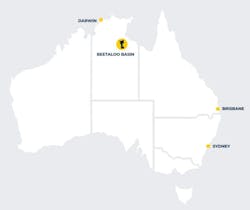Tamboran begins Beetaloo sub-basin drilling campaign
Tamboran (B2) Pty. Ltd. spudded the Shenandoah South 2H (SS2H) horizontal well in EP 98 in Beetaloo sub-basin, Northern Territory, Australia, said JV partner Falcon Oil & Gas Ltd. in an Aug. 30 release.
Following drilling of SS2H, Tamboran B2 will immediately move to the Shenandoah South 3H (SS3H) well off the same well pad ahead of the stimulation program.
Both wells will be drilled with an H&P Rig, will include a horizontal section of about 3,000 m, and will target the Amungee Member B-shale at an estimated target depth of 3,020 m. Each well is expected to be drilled in 30 days.
The wells will be stimulated with up to 60 stages utilizing the Liberty Energy frac fleet being mobilized from the US to Australia. The companies expect the increased efficiency and performance of the Liberty fleet to result in a material increase in the completed stages per day and optimized gas flows.
Initial flow test results from each well are expected first-quarter 2025. Once flow testing is complete, both wells will be suspended as future producers to supply the proposed 40-MMcfd Shenandoah South Pilot Project, expected to start production first-half 2026, subject to final stakeholder and regulatory approvals (OGJ Online, March 24, 2024).
The two-well program will be the largest single campaign in Beetaloo sub-basin to date. An additional four-well program is planned for 2025.
Beetaloo sub-basin is a relatively underexplored onshore basin which contains Proterozoic and Cambrian tight oil and gas. The sub-basin covers about 8.7 million acres.
Falcon Australia will participate in both wells in the Shenandoah South Pilot Project at its elected interest of 5%.
Tamboran is operator of EP98 (77.5%). Falcon holds the remaining 22.5%.
About the Author
Alex Procyk
Upstream Editor
Alex Procyk is Upstream Editor at Oil & Gas Journal. He has also served as a principal technical professional at Halliburton and as a completion engineer at ConocoPhillips. He holds a BS in chemistry (1987) from Kent State University and a PhD in chemistry (1992) from Carnegie Mellon University. He is a member of the Society of Petroleum Engineers (SPE).

